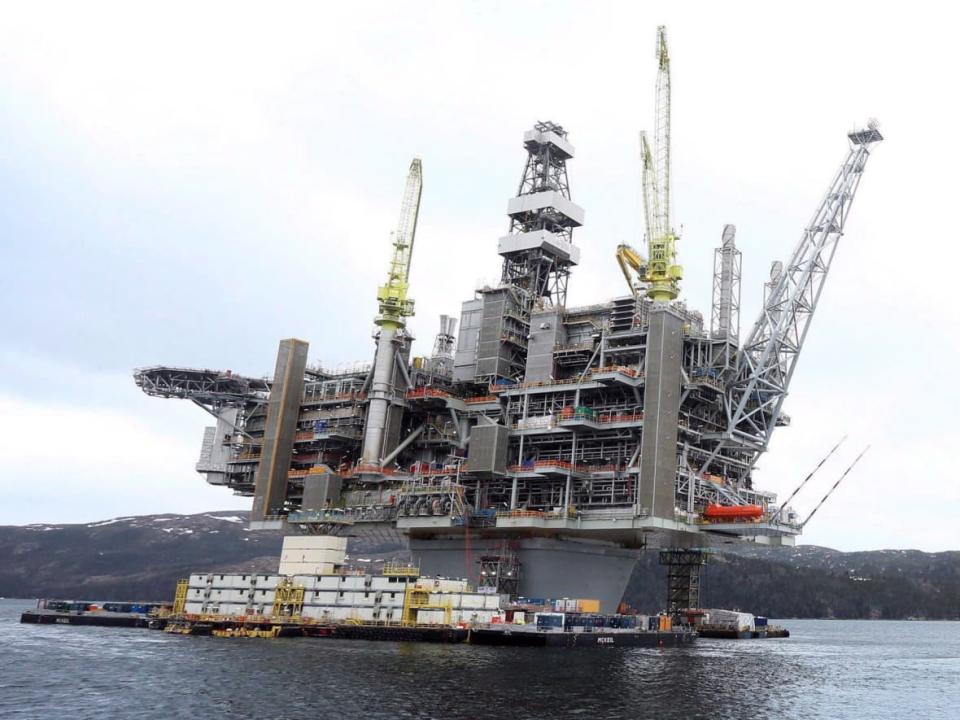Heavy crude now makes up about half of N.L.'s production

Heavy oil makes up an increasingly large proportion of the crude produced off Newfoundland, according to the latest annual report of the province's oil regulator.
The data calls into question the provincial and federal governments' repeated assertions about light Newfoundland oil forming an integral part of the global energy transition.
Data from the Canada-Newfoundland and Labrador Offshore Petroleum Board shows that in 2020-21, more than half of the nearly 100 million barrels of crude produced at three major oil fields came from one project: Hebron. (Production at Terra Nova, the province's fourth major field, is currently offline.)
The vast majority of Hebron production comes from the Ben Nevis reservoir, which extracts crude with an API gravity of 19.8, meaning it's considered heavy oil by both the Canada Energy Regulator and the Canadian Association of Petroleum Producers.
Hebron oil, with an API gravity of around 20, has a texture similar to molasses or honey. Oil from Hibernia or White Rose, whose gravity ranges from 30 to 40, has a texture closer to water.
Heavier oil, more intensive refining
"There's going to be more energy required in order to break down the chains of the molecules of that heavy oil in order to bring it to a commercial product that can be used. So there will be, obviously, more emissions coming out of that process," said Farshid Torabi, professor of petroleum systems engineering at the University of Regina.
"The heavier the oil, the more effort and energy is required to thermally crack down the molecules and break down the chains", he said, while adding oil companies take "great measures" to reduce emissions to a minimum during refining.
Andrew Parsons, the province's energy minister, wouldn't do an interview.
A statement sent by spokesperson Kelly-Anne Roberts and attributed to the Department of Industry, Energy and Technology said demand for Hebron oil remains high and that "upstream emissions intensity (extraction) for Hebron in 2020 was the lowest in the offshore."
"Upstream emissions intensity for the offshore is mainly a function of how much oil a field is producing and how efficient the facility is from an emissions perspective (particularly power generation and flare)," the statement reads.
Over time, heavy oil from Hebron "is anticipated to become lighter as the other reservoirs (Hibernia, Jeanne d'Arc) come online," the deparment added, adding the oil contain relatively low amounts of sulfur, meaning it "is less expensive to refine and would result in lower associated emissions."
Lesley Rideout, spokesperson for the C-NLOPB, said in an email that the board "has not adopted a standard for differentiating 'heavy' vs. 'light.' We also don't track the breakdown of the volume of heavy crude vs. light crude."
Rideout also said that while most of the crude produced at Hebron is heavy oil, it is extracted without changing its viscosity, as is typically the case with heavier crude.
"All petroleum production from the N.L. offshore is produced conventionally, without the use of thermal stimulation methods such as steam injection," she said.
Government accused of greenwashing
For years, the federal and provincial governments have promoted the offshore oil industry and investment in light, sweet Newfoundland crude, for which emissions related to production are relatively lower.
Last month, Premier Andrew Furey travelled to Glasgow to participate in the UN climate summit and make the case for Newfoundland and Labrador oil as the planet transitions away from fossil fuels.
Angela Carter, an associate professor of political science at the University of Waterloo, said she believes the provincial government is purposely playing down the amount of heavy oil produced off Newfoundland and the emissions it creates.
"These are messages to try to convince the public and maybe the industry as well that, you know, the government is still supportive of the fossil fuel sector or oil extraction in Newfoundland and Labrador. It's not rooted in climate science," she said.
Carter said even if production at the Hebron platform creates relatively less emissions, compared with other offshore projects, she believes the government is painting over the downstream emissions created by Newfoundland oil — by transporting, refining, then burning the fossil fuels.
"We need to stop focusing on what's happening just at the point of extraction," she said. "It is very convenient for the oil industry, but it is not helpful to people in Newfoundland and Labrador, certainly not at a moment of climate crisis. So it's, how can I say it? It's greenwashing."

 Yahoo Finance
Yahoo Finance 